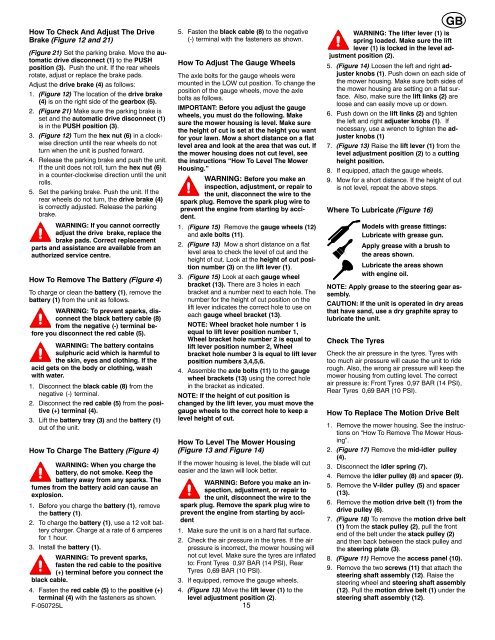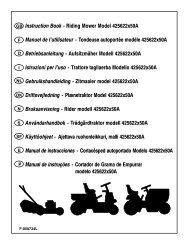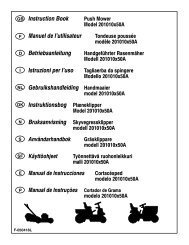Instruction Book − Riding Mower Model ... - Safe Motor AS
Instruction Book − Riding Mower Model ... - Safe Motor AS
Instruction Book − Riding Mower Model ... - Safe Motor AS
You also want an ePaper? Increase the reach of your titles
YUMPU automatically turns print PDFs into web optimized ePapers that Google loves.
How To Check And Adjust The Drive<br />
Brake (Figure 12 and 21)<br />
(Figure 21) Set the parking brake. Move the automatic<br />
drive disconnect (1) to the PUSH<br />
position (3). Push the unit. If the rear wheels<br />
rotate, adjust or replace the brake pads.<br />
Adjust the drive brake (4) as follows:<br />
1. (Figure 12) The location of the drive brake<br />
(4) is on the right side of the gearbox (5).<br />
2. (Figure 21) Make sure the parking brake is<br />
set and the automatic drive disconnect (1)<br />
is in the PUSH position (3).<br />
3. (Figure 12) Turn the hex nut (6) in a clockwise<br />
direction until the rear wheels do not<br />
turn when the unit is pushed forward.<br />
4. Release the parking brake and push the unit.<br />
If the unit does not roll, turn the hex nut (6)<br />
in a counter-clockwise direction until the unit<br />
rolls.<br />
5. Set the parking brake. Push the unit. If the<br />
rear wheels do not turn, the drive brake (4)<br />
is correctly adjusted. Release the parking<br />
brake.<br />
WARNING: If you cannot correctly<br />
adjust the drive brake, replace the<br />
brake pads. Correct replacement<br />
parts and assistance are available from an<br />
authorized service centre.<br />
How To Remove The Battery (Figure 4)<br />
To charge or clean the battery (1), remove the<br />
battery (1) from the unit as follows.<br />
WARNING: To prevent sparks, disconnect<br />
the black battery cable (8)<br />
from the negative (-) terminal before<br />
you disconnect the red cable (5).<br />
WARNING: The battery contains<br />
sulphuric acid which is harmful to<br />
the skin, eyes and clothing. If the<br />
acid gets on the body or clothing, wash<br />
with water.<br />
1. Disconnect the black cable (8) from the<br />
negative (-) terminal.<br />
2. Disconnect the red cable (5) from the positive<br />
(+) terminal (4).<br />
3. Lift the battery tray (3) and the battery (1)<br />
out of the unit.<br />
How To Charge The Battery (Figure 4)<br />
WARNING: When you charge the<br />
battery, do not smoke. Keep the<br />
battery away from any sparks. The<br />
fumes from the battery acid can cause an<br />
explosion.<br />
1. Before you charge the battery (1), remove<br />
the battery (1).<br />
2. To charge the battery (1), use a 12 volt battery<br />
charger. Charge at a rate of 6 amperes<br />
for 1 hour.<br />
3. Install the battery (1).<br />
WARNING: To prevent sparks,<br />
fasten the red cable to the positive<br />
(+) terminal before you connect the<br />
black cable.<br />
4. Fasten the red cable (5) to the positive (+)<br />
terminal (4) with the fasteners as shown.<br />
F-050725L<br />
5. Fasten the black cable (8) to the negative<br />
(-) terminal with the fasteners as shown.<br />
How To Adjust The Gauge Wheels<br />
The axle bolts for the gauge wheels were<br />
mounted in the LOW cut position. To change the<br />
position of the gauge wheels, move the axle<br />
bolts as follows.<br />
IMPORTANT: Before you adjust the gauge<br />
wheels, you must do the following. Make<br />
sure the mower housing is level. Make sure<br />
the height of cut is set at the height you want<br />
for your lawn. Mow a short distance on a flat<br />
level area and look at the area that was cut. If<br />
the mower housing does not cut level, see<br />
the instructions “How To Level The <strong>Mower</strong><br />
Housing.”<br />
WARNING: Before you make an<br />
inspection, adjustment, or repair to<br />
the unit, disconnect the wire to the<br />
spark plug. Remove the spark plug wire to<br />
prevent the engine from starting by accident.<br />
1. (Figure 15) Remove the gauge wheels (12)<br />
and axle bolts (11).<br />
2. (Figure 13) Mow a short distance on a flat<br />
level area to check the level of cut and the<br />
height of cut. Look at the height of cut position<br />
number (3) on the lift lever (1).<br />
3. (Figure 15) Look at each gauge wheel<br />
bracket (13). There are 3 holes in each<br />
bracket and a number next to each hole. The<br />
number for the height of cut position on the<br />
lift lever indicates the correct hole to use on<br />
each gauge wheel bracket (13).<br />
NOTE: Wheel bracket hole number 1 is<br />
equal to lift lever position number 1,<br />
Wheel bracket hole number 2 is equal to<br />
lift lever position number 2, Wheel<br />
bracket hole number 3 is equal to lift lever<br />
position numbers 3,4,5,6.<br />
4. Assemble the axle bolts (11) to the gauge<br />
wheel brackets (13) using the correct hole<br />
in the bracket as indicated.<br />
NOTE: If the height of cut position is<br />
changed by the lift lever, you must move the<br />
gauge wheels to the correct hole to keep a<br />
level height of cut.<br />
How To Level The <strong>Mower</strong> Housing<br />
(Figure 13 and Figure 14)<br />
If the mower housing is level, the blade will cut<br />
easier and the lawn will look better.<br />
WARNING: Before you make an inspection,<br />
adjustment, or repair to<br />
the unit, disconnect the wire to the<br />
spark plug. Remove the spark plug wire to<br />
prevent the engine from starting by accident<br />
1. Make sure the unit is on a hard flat surface.<br />
2. Check the air pressure in the tyres. If the air<br />
pressure is incorrect, the mower housing will<br />
not cut level. Make sure the tyres are inflated<br />
to: Front Tyres 0,97 BAR (14 PSI), Rear<br />
Tyres 0,69 BAR (10 PSI).<br />
3. If equipped, remove the gauge wheels.<br />
4. (Figure 13) Move the lift lever (1) to the<br />
level adjustment position (2).<br />
15<br />
GB<br />
WARNING: The lifter lever (1) is<br />
spring loaded. Make sure the lift<br />
lever (1) is locked in the level adjustment<br />
position (2).<br />
5. (Figure 14) Loosen the left and right adjuster<br />
knobs (1). Push down on each side of<br />
the mower housing. Make sure both sides of<br />
the mower housing are setting on a flat surface.<br />
Also, make sure the lift links (2) are<br />
loose and can easily move up or down.<br />
6. Push down on the lift links (2) and tighten<br />
the left and right adjuster knobs (1). If<br />
necessary, use a wrench to tighten the adjuster<br />
knobs (1)<br />
7. (Figure 13) Raise the lift lever (1) from the<br />
level adjustment position (2) to a cutting<br />
height position.<br />
8. If equipped, attach the gauge wheels.<br />
9. Mow for a short distance. If the height of cut<br />
is not level, repeat the above steps.<br />
Where To Lubricate (Figure 16)<br />
<strong>Model</strong>s with grease fittings:<br />
Lubricate with grease gun.<br />
Apply grease with a brush to<br />
the areas shown.<br />
Lubricate the areas shown<br />
with engine oil.<br />
NOTE: Apply grease to the steering gear assembly.<br />
CAUTION: If the unit is operated in dry areas<br />
that have sand, use a dry graphite spray to<br />
lubricate the unit.<br />
Check The Tyres<br />
Check the air pressure in the tyres. Tyres with<br />
too much air pressure will cause the unit to ride<br />
rough. Also, the wrong air pressure will keep the<br />
mower housing from cutting level. The correct<br />
air pressure is: Front Tyres 0,97 BAR (14 PSI),<br />
Rear Tyres 0,69 BAR (10 PSI).<br />
How To Replace The Motion Drive Belt<br />
1. Remove the mower housing. See the instructions<br />
on “How To Remove The <strong>Mower</strong> Housing”.<br />
2. (Figure 17) Remove the mid-idler pulley<br />
(4).<br />
3. Disconnect the idler spring (7).<br />
4. Remove the idler pulley (8) and spacer (9).<br />
5. Remove the V-ilder pulley (5) and spacer<br />
(13).<br />
6. Remove the motion drive belt (1) from the<br />
drive pulley (6).<br />
7. (Figure 18) To remove the motion drive belt<br />
(1) from the stack pulley (2), pull the front<br />
end of the belt under the stack pulley (2)<br />
and then back between the stack pulley and<br />
the steering plate (3).<br />
8. (Figure 11) Remove the access panel (10).<br />
9. Remove the two screws (11) that attach the<br />
steering shaft assembly (12). Raise the<br />
steering wheel and steering shaft assembly<br />
(12). Pull the motion drive belt (1) under the<br />
steering shaft assembly (12).





